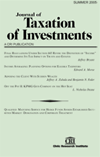When to Consider Tax Efficient ETFs in Taxable Accounts as an Alternative to High-Fee 401(k) Plans
Author: Richard B. Toolson.
Source: Volume 29, Number 04, Summer 2012 , pp.3-18(16)

next article > |return to table of contents
Abstract:
This article focuses on when an individual would be better off investing funds not matched by an employer in a taxable broadmarket, low-cost, tax-efficient equity ETF rather than in equity funds offered in a 401(k) plan that carries significant fees. Different levels of annual fees for the 401(k) plan, different tax rates for the taxable ETF, different holding periods, and an annual rate of return of 8 percent (6 percent capital gains and 2 percent dividend rates) are assumed. The results generally indicate that all taxpayers, regardless of tax bracket, do better in a 401(k) plan if the annual expense ratio is less than 0.5 percent. At an expense ratio of 1 percent, low-bracket taxpayers are better off in a taxable account whereas high- and middle-bracket taxpayers are better off in a 401(k). If expense ratios are higher than 1.5 percent, individuals across all tax brackets should opt for the taxable ETF.Keywords: Exchange Traded Funds, 401(k) plans, expense ratio, retirement planning, broad-index ETFs vs. mutual funds
Affiliations:
1: Washington State University.